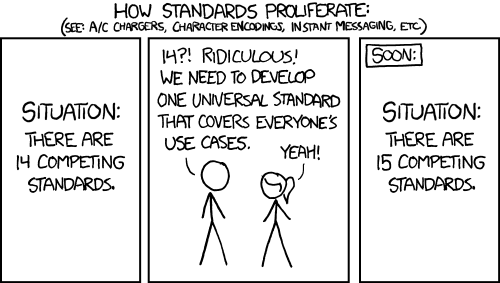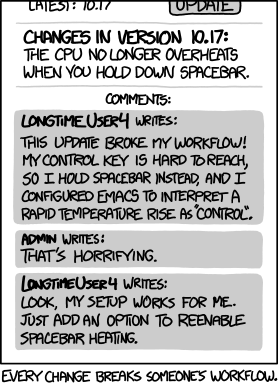DevTools > Traps for Tool Builders
There are some anti-patterns that I often see tool builders fall into:
Fixating on tools instead of problems
The tools we build are an end to the means and not an end in themselves: focus on the problems being solved instead. A symptom is a poorly functional Frankenstein swiss army knife that started its existence as a hammer.
Solving this behavior is somewhat tricky: you want to incentivize your tools teams to take good care of the tools they build without causing tunnel vision.
One approach is to have part of your team responsible purely for the tool itself, while a different part works towards new solutions for problems; with goals and incentives aligned appropriately.
Assuming your customers care about tools
Most of your customers don't spend their days thinking about the tools they use, the underlying complexity, or how much their lives could be better with nicer tooling.
Instead, they're trying to get their jobs done: shipping products, building infrastructure, training models, etc. Each tool is one of the hundreds they encounter every day, and they're generally not thinking about it as they go about their work.
There are two significant consequences:
- Too much subtlety in a tool will backfire: it should be simple, obvious, and direct. Don't take up more space in your customer's brain than you need to.
- Be careful of direct asks from customers: understand their problem deeply, but consider all solutions instead of only the ones they recommend. Often enough, they don't have a sense of what's possible with good tools, but you do.
Starting by consolidating all the things
The most observable problem is generally an over-proliferation of tools people need to use in their day-to-day jobs. The solution is to often invent the n+1th iteration that inevitably does only ~90% of what the original tools did, and generally imperfectly with less flexibility.
XKCD captures this perfectly: standards, tools, processes, books; this is one pattern that repeats again and again.

I have a couple of recommendations to avoid this particular trap:
- Make sure you identify the actual pain points before quixotically tilting towards the windmills of One Browser Tab and stuffing a lot of workflows into a kitchen-sink equivalent. Prioritize these and actually speed up people.
- There will be some places where consolidation does make significant sense: particularly if a lot of information needs to move between tools and is manually copy/pasted. Prioritize interlocked/coupled systems, allowing for smoother workflows.
- When you do work on tool consolidation, choose the least broken and most comprehensive existing tool and improve it in place. Your changes will get validated in real-time, and you'll work with full awareness of all the complex edge conditions (particularly the sneaky ones that tend to derail the best-run projects).
- Coupling tools strongly leads to fewer options: try to make different tools compose smoothly and keep them flexible to maximize the value they provide.
Making things worse without realizing it
The downside of having so much leverage is that you also can make things significantly more painful for your fellow developers.
In more obvious ways: breaking or slowing down tools will have significant consequences for the happiness and productivity of everyone around you.
In more insidious ways: simply changing existing workflows comes with a high cost that generally doesn't bubble up very obviously. Any change to an existing workflow will come with a price to your current customers, particularly the power users. Be intentional about what you change, and always try to do it in a backward-compatible way.
You're almost certainly going to be surprised at the different workflows people have adopted around your tools.

Prioritizing form over function
A trap I repeatedly fall into is unconsciously prioritizing a pixel-perfect layout instead of building a valuable tool.
If a tool can get the job done, people will use it regardless of a dated, painful UI. If it can't get the job done, people will not use it irrespective of how polished it looks.
In a perfect world, aim for both polish and features; if you have to drop one, drop the polish. Do remember that a functional but unusable tool doesn't get the job done either. I never said this would be easy.
Iterating too slowly
If your tools-teams need tools-teams, you might need to reconsider. Large teams will be more likely to build more complex solutions with far less leverage than smaller, more focused teams.
As always, this is a balance to maintain: too small a team will self-destruct with burnout; too large a group will collapse under its weight.
Just make sure that you can adapt to the changing world – and your customer's needs – quickly. Tools should improve much faster than the final product being built. Building something that would have been useful six months ago is worse than not building anything at all.
Overwhelming your customers
Two insidious traps to avoid while interacting with customers:
- Don't rely on a game of telephone to understand your customers' needs. More often than not, the customers are engineers you work with – talk to them directly and make sure you truly understand the problems they need to be solved.
- Don't ask customers too many questions either: they still need to get their jobs done. Be disciplined about how much of your customers' time you use; document everything you learn to avoid repeatedly asking the same questions.
Avoiding domain-specific knowledge
A typical behavior I see in toolsmiths is that they avoid going deep into the domain they're building tools for, often staying just at the fringes and relying on customer reports to figure out if their work is valuable.
Please don't do this: I've been this person a couple of times in the past, and I've inevitably left a lot of impact lying on the table because I didn't realize how useful some features would have been (instead of polishing UI or taking customers at face value). Primarily because of a lack of time and not by choice.
You can short circuit this process by hiring engineers with domain knowledge to help build out your tools – even if they're only on loan from your customers. Time spent deep in the domain doing the work pays for itself very quickly.
Ignoring the surrounding systems and context
The constraints and options available to an internal tools team are incredibly different from those available to a company building developer tools for enterprise customers. It's generally not a good idea to copy/paste approaches – particularly around identifying and releasing products – directly.
Make sure you make the most of your environment: an internal tools team can ship much more rapidly, deeply understand their customers, and build significantly more bespoke tooling. Tooling companies can solve much broader problems with far more resources and options to make the best tool possible.
Assuming there's one ideal way to do things
People think in different ways: everyone has their approach to solving problems – and different sets of tools they prefer to use. Assuming that there's precisely one perfect solution for everything will overly constrain your solutions – or make them impossible to implement.
Building composable, extensible tools help navigate this better: for example, the Language Server Protocol brings excellent tools into all editors. Building LSPs avoids constraining the choice of IDE (which tends to be highly personal) but still helps add value for all engineers.
Believing that tools can replace thinking
There's only so much that tools can do: they can't replace someone actively and carefully thinking about the problem at hand. Don't expect them to – and don't set expectations that they can – to avoid unnecessary disappointment and heartbreak later.
Comments
Add your comments to this Twitter thread, or drop me an email.
7/ https://t.co/cLEyZlfuej
— Kunal Bhalla (@kunalbhalla) June 24, 2021
There are several common failure modes while building tools. I still don't manage to avoid these, but I hope you will.